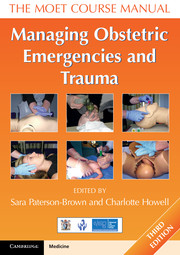Book contents
- Frontmatter
- Dedication
- Contents
- Working Group
- About the authors
- Acknowledgements
- Abbreviations
- Section 1 Introduction
- Section 2 Recognition
- Section 3 Resuscitation
- Section 4 Trauma
- Section 5 Other medical and surgical emergencies
- Section 6 Obstetric emergencies
- 24 Pre-eclampsia and eclampsia
- 25 Major obstetric haemorrhage
- 26 Caesarean section
- 27 Placenta accreta and retained placenta
- 28 Uterine inversion
- 29 Ruptured uterus
- 30 Ventouse and forceps delivery
- 31 Shoulder dystocia
- 32 Umbilical cord prolapse
- 33 Face presentation
- 34 Breech delivery and external cephalic version
- 35 Twin pregnancy
- 36 Complex perineal and anal sphincter trauma
- 37 Symphysiotomy and destructive procedures
- 38 Anaesthetic complications in obstetrics
- Section 7 Triage and transfer
- Section 8 Human issues
- Index
24 - Pre-eclampsia and eclampsia
- Frontmatter
- Dedication
- Contents
- Working Group
- About the authors
- Acknowledgements
- Abbreviations
- Section 1 Introduction
- Section 2 Recognition
- Section 3 Resuscitation
- Section 4 Trauma
- Section 5 Other medical and surgical emergencies
- Section 6 Obstetric emergencies
- 24 Pre-eclampsia and eclampsia
- 25 Major obstetric haemorrhage
- 26 Caesarean section
- 27 Placenta accreta and retained placenta
- 28 Uterine inversion
- 29 Ruptured uterus
- 30 Ventouse and forceps delivery
- 31 Shoulder dystocia
- 32 Umbilical cord prolapse
- 33 Face presentation
- 34 Breech delivery and external cephalic version
- 35 Twin pregnancy
- 36 Complex perineal and anal sphincter trauma
- 37 Symphysiotomy and destructive procedures
- 38 Anaesthetic complications in obstetrics
- Section 7 Triage and transfer
- Section 8 Human issues
- Index
Summary
Objectives
On successfully completing this topic, you will be able to:
understand the management of severe hypertension in pregnancy
prevent and treat eclamptic fits
manage fluid balance in pre-eclampsia/eclampsia
investigate, recognise and treat the complications of the condition.
Introduction
Definitions: pre-eclampsia and eclampsia
Pre-eclampsia is pregnancy-induced hypertension in association with proteinuria or oedema or both. Virtually any organ system may be effected.
The Magpie trial defined severe pre-eclampsia as:
• diastolic blood pressure greater than 110 mmHg on two occasions or systolic blood pressure greater than 170 mmHg on two occasions and proteinuria greater than 3+ or
• diastolic blood pressure greater than 100 mmHg on two occasions and proteinuria greater than 2+ and at least two signs or symptoms of imminent eclampsia.
Eclampsia is defined as the occurrence of one or more convulsions during pregnancy or the first 10 days postpartum, together with at least two of the following features within 24 hours of the convulsions:
• hypertension
• proteinuria
• thrombocytopenia
• elevated liver enzymes.
HELLP (haemolysis, elevated liver enzymes and low platelets) syndrome is an important variant of pre-eclampsia. Strictly, a diagnosis of HELLP syndrome needs confirmation of haemolysis, either by measuring lactate dehydrogenase (LDH) levels, as commonly carried out in the US, or by blood film to look for fragmented red cells. Alanine aminotransferase (ALT) levels above 75IU/l are seen as significant and levels above 150 IU/l are associated with increased morbidity to the mother. The platelet count should be below 100 x 109/litre to support the diagnosis.
- Type
- Chapter
- Information
- Managing Obstetric Emergencies and TraumaThe MOET Course Manual, pp. 277 - 296Publisher: Cambridge University PressPrint publication year: 2014

